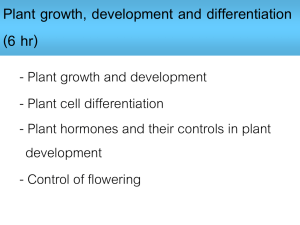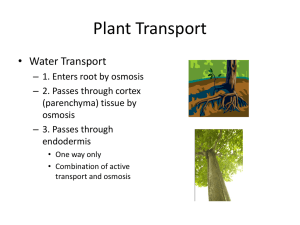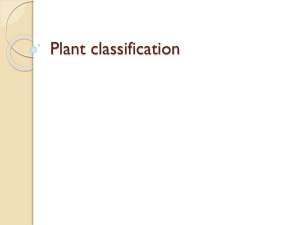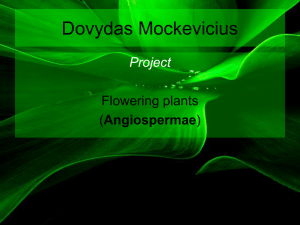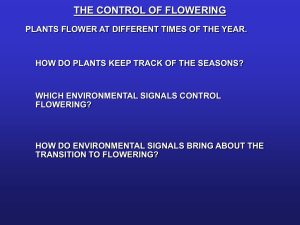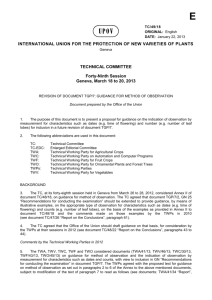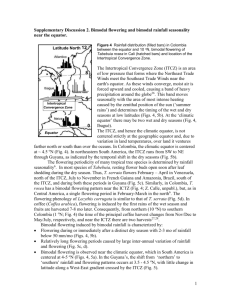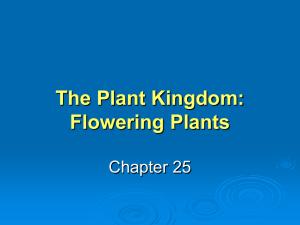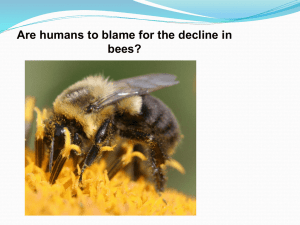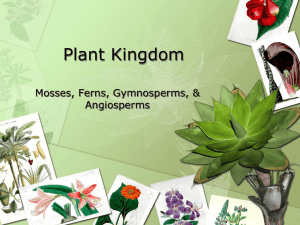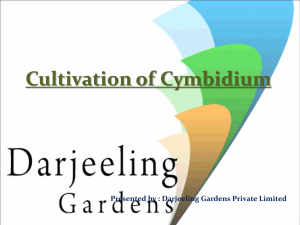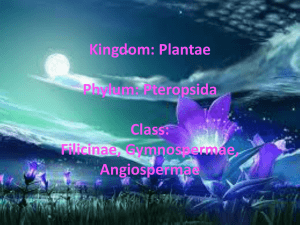Flowering Plants - Herscher CUSD #2
advertisement
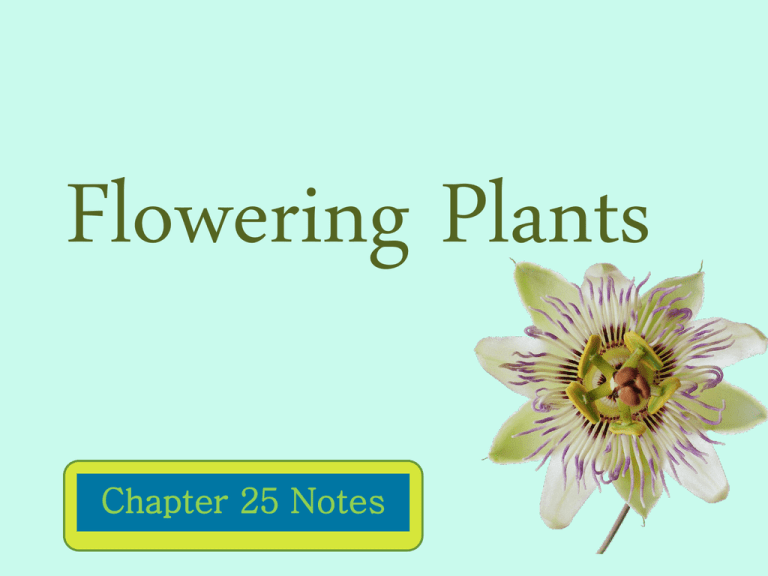
Flowering Plants Chapter 25 Notes Angiosperms • • • • Phylum Anthophyta Anthus “flower” phyt “plant” 300,000+ species Earth’s Dominant Plants Flowering Plants • Like gymnosperms: – Flowering plants have vascular tissues and produce seeds – Heterosporous – megaspores and microspores • Unlike gymnosperms: – Ovules of flowering plants are enclosed within an ovary KEY TERMS • OVULE – Structure in the ovary that contains a female gametophyte and develops into a seed after fertilization • OVARY – Base of a carpel or fused carpels that contains ovules and develops into a fruit after fertilization Orange Fruit Development The Function of Fruits • Protects seeds as they grow and mature • Seed Dispersal Flower Parts Female Parts The Pistil – 1+ Carpels • Stigma - sticky • Style – the neck connecting stigma to ovary • Ovary – houses ovules (each contains 1 egg) Male Parts The Stamen • Anther – produces pollen grains • Filament - stalk Ecology and Economy • Our survival as a species depends on flowering plants – Major food crops • Products – Cork, rubber, tobacco, coffee, chocolate, aromatic oils for perfumes – Valuable lumber – Fibers and medicines – Clothing Economic Botany • Subdiscipline of botany that deals with plants of economic importance – Most of these are flowering plants KEY TERMS • COTYLEDON – The seed leaf of a plant embryo, which may contain food stored for germination KEY TERMS • MONOCOT – Seeds contain a single cotyledon – Monocots have floral parts in threes – Monocots include grasses, orchids, irises, onions, lilies, palms • Mostly Herbaceous KEY TERMS • EUDICOT – Seeds contain two cotyledons – Eudicots have floral parts in fours or fives – Eudicots include oaks, roses, mustards, cacti, blueberries, sunflowers Life Cycle • Flowering plants undergo an alternation of generations: – Sporophyte generation is larger and nutritionally independent – Gametophyte generation is reduced to only a few microscopic cells KEY TERMS • DOUBLE FERTILIZATION – A process in the flowering plant life cycle in which there are two fertilizations – One results in formation of a zygote – Second results in formation of endosperm KEY TERMS • ENDOSPERM – The 3n nutritive tissue formed at some point in the development of all angiosperm seeds – Formed by double fertilization • The two polar nuclei fuse with the second sperm cell Life Cycle: Flowering Plants Pollen Grains Adaptations of Flowering Plants • Reproduce sexually by forming flowers • Form seeds within fruits after double fertilization • Efficient water-conducting vessel elements in xylem • Efficient carbohydrate-conducting sieve-tube elements in phloem • Have pollen grains transported by wind, water, insects, other animals KEY TERMS • APOMIXIS – A type of reproduction – Fruits and seeds are formed asexually – No fusion of gametes – Embryo is genetically similar to parent – Plants that reproduce by apomixis: dandelions, citrus trees, blackberries, garlic, certain grasses. Adaptability of Flowering Plants KEY TERMS • BASAL ANGIOSPERM – Group of angiosperms thought to be ancestral to all other flowering plants • CORE ANGIOSPERM – Group including most angiosperm species – Divided into three subgroups: magnoliids, monocots, and eudicots KEY TERMS • MAGNOLIID – One of the groups of flowering plants – Core angiosperms once classified as “dicots,” but molecular evidence indicates they are neither eudicots nor monocots – Includes species in magnolia, laurel, and black pepper families, several related families It’s Chart Time! Woo Hoo! Flowering Plant Families 1 • More than 300 families • Magnolia family – Important ornamentals and source of timber – Examples: southern magnolia, tuliptree Magnolia Family Flowering Plant Families 2 • Walnut family – Provides nuts for food, wood for furniture – Examples: English walnut, black walnut, pecan • Cactus family – Important as ornamentals – Examples: prickly pear, Christmas cactus Walnut Family Fig. 25-10b, p. 498 Fig. 25-10c, p. 498 Cactus Family Flowering Plant Families 3 • Mustard family – Many important food crops – Examples: cabbage, broccoli, cauliflower, turnip, mustard • Rose family – Commercially important fruits and ornamentals – Examples: apple, pear, plum, cherry, apricot, peach, strawberry, raspberry, rose Mustard Family Mustard Family Mustard Family Mustard Family Rose Family Rose Family Rose Family Flowering Plant Families 4 • Pea family – Important food crops – Examples: garden pea, chick pea, green bean, soybean, lima bean, peanut, red clover, alfalfa Pea Family Pea Family Pea Family Flowering Plant Families 5 • Potato family – Important food crops and chemicals used as drugs – Examples: potato, tomato, green pepper, eggplant, petunia, deadly nightshade (belladonna) Potato Family Flowering Plant Families 6 • Pumpkin family – Food crops – Examples: pumpkins, melons, squashes, cucumbers, cantaloupe, honeydew, muskmelon, cucumber, watermelon Pumpkin Family Pumpkin Family Flowering Plant Families 7 • Sunflower family – One of the largest families of flowering plants – Examples: chrysanthemums, marigolds, sunflowers, daisies, and some food plants such as lettuce, globe artichokes Sunflower Family Flowering Plant Families 8 • Grass family – Most important family of flowering plants from the human standpoint – Examples: rice, wheat, corn, oats, barley, rye, sugarcane, bamboo Grass Family Flowering Plant Families 9 • Orchid family – One of the largest families of flowering plants; contains a greater variety of flowers than any other family – Example: the vanilla orchid • Agave family – Best known for ornamentals – Examples: century plant, sisal hemp, bowstring hemp Orchid Family
